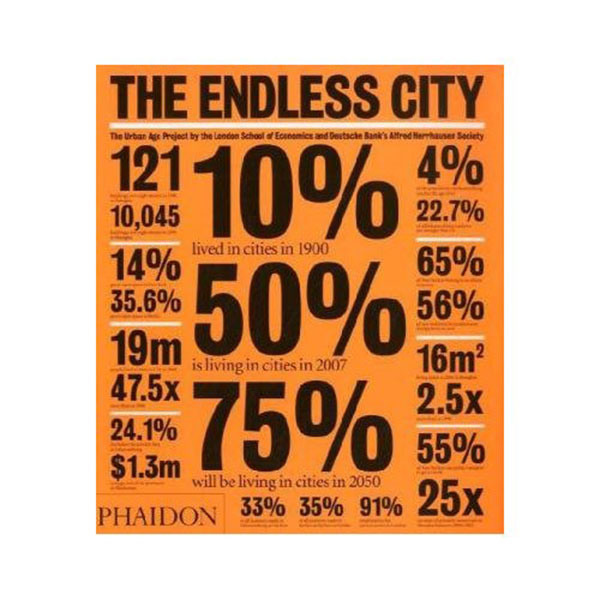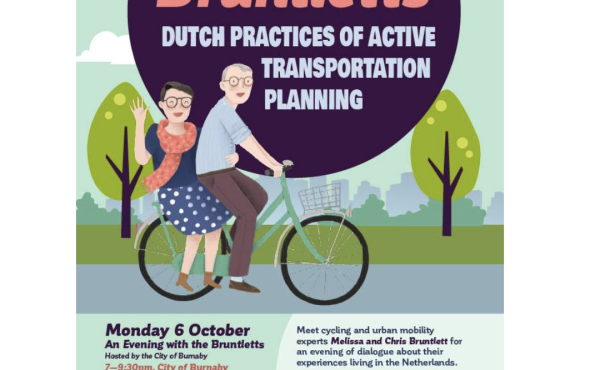
Editors: Ricky Burdett and Deyan Sudjic (Phaidon, 2008)
At the turn of the 21st century, the world is faced with the unprecedented challenge of addressing the fundamental shift of the world’s population away from humanity’s rural roots towards cities. This global phenomenon is being felt in every facet of our daily lives and is the first such undertaking in humankind’s known history.
Even locally, only 15% of BC residents currently live in rural areas and, continually, these people are draining away from formerly thriving resource towns of northwestern BC and the central coast to the major urban nodes throughout the province.
As an event without precedent, many of the urban issues developing as a result of this situation have been generating a lot of critical discussion around the globe. The Urban Age Project – begun in 2004 and organized by the London School of Economics and Political Science, and Deutsche Bank’s Alfred Herrhausen Society – emerged from this context.
This worldwide investigation brought together an international and interdisciplinary network of national and local policy makers, academic experts and urban practitioners to discuss the long-term future of our urban settlements and the connections between urban form (housing, transportation, infrastructure, public space, etc.) and urban society (social, economic and political processes). Towards this end, the Urban Age brought together on research a diversity of cities around the globe
It was from this colossal endeavour that The Endless City emerged. Edited by Rick Burdett and Deyan Sudjic, this book focuses at the complex urban conditions of six different cities – New York, Shanghai, London, Mexico City, Johannesburg, and Berlin – as manifestations of larger global urban trends.
Within its imposing 510 pages, The Endless City includes a wide variety of respected and influential contributors – such as Richard Sennett, Enrique Penalosa, and Rem Koolhass – discussing a diverse range of topics such as density, transportation, ethnicity, social straticification, and public space.
The book is structured into six overarching sections – Introduction, Cities, Issues, Interventions, Positions, and Index – each of which is divided into several smaller pieces. The Introduction consists of three essays describing the Urban Age initiative and how the project came to be. Two essays in particular (one authored by Ricky Burdett and Philipp Rode, and the other by Dejun Sudjic) are excellent in summarizing the variety of issues that face cities in light of the urban tsunami currently taking place.
As the section title suggests, Cities look specifically at the six cities in question. Covering approximately half of the book, this section is a small book in itself, with its own introductory essay, and chapters on each city consisting of three essays that describe several issues pertaining to each locality. Each city is introduced by a few pages of beautiful images, summary statistics and residential density maps.
The essays themselves are quite easy to read and pretty good at giving readers a general understanding of the range of problems, solutions and opportunities faced by each city. They lean more towards being descriptive (vs. analytical) and have a certain amount of redundancy between them – as they relate to each particular city. As such, those who have some background knowledge regarding any of the cities, may not find them overly engaging. That said, they are an important introduction to the overall themes of the book.
The Cities section ends with an excellent data and statistical analysis/comparison of all six Urban Age cities. The topics of the analysis range from size and density, to the spatial distribution of work and children. Each information graphic is quite well done and clear, and is annotated with a short written description of the theme in question. Furthermore, and most importantly, the information for each city is placed beside one another across a two-page spread, making for easy and quick graphic comparison (a seemingly basic graphic principle, lost on many other similar books comparing data).
At approximately one-fifth of the book, the Issues section is the meat of the book. It consists of 14 in-depth essays written by a diversity of contributors critically discussing a multitude of themes that pertain to the cities as a whole but referring (sometimes loosely) back to the six Urban Age cities. The writing style varies accordingly, with some having a more academic, jargon-based tone to them and other very accessible to the average reader. As such, some were more engaging than others…but all had something interesting to say. A few I found particularly noteworthy are:
The Open City by Richard Sennett – re-examines the ideas of Jane Jacobs for an “open” city that can engage people of all ages, sexes, ethnicites, and socio-economic backgrounds.
Politics, Power, Cities by Enrique Penalosa – discusses social (in)equality as it is made manifest in the contemporary city as well as the important roles of public space, transportation and government policy.
The Death and Life of the Urban Office by Frank Duffy – a very interesting look at the forces that have shaped the design of office space in the city and how current office developments are not keeping pace with the radical changes in the nature of office work brought about by the technological progress for the past two decades.
Confronting Fear by Sophie Body-Gendrot – looks at threats, fear, and security in cities and how to go about creating the feeling of safety among its communities.
At Home in the City by Anne Power – Echoing the writings of Jane Jacobs, this essay focuses on the importance of the adaptation, recycling, and reuse of buildings in our cities as a means of housing the incoming flood of urban residents.
Towards A Carbon Neutral London by Nicky Gavron – an in-depth (and inspiring) look at how London has aggressively and progressively moved towards carbon neutrality and the London Plan that was born from this movement.
These essays lead to the Interventions section, that succinctly describe 20 projects that demonstrate new urban thinking in the six Urban Age cities. They were chosen to represent “various intersections of the Urban Age themes: Labour Markets and Workplaces, Mobility and Transport, Housing and Urban Neighbourhoods and Public Life and Urban Space – categories that frequently overlap and merge given the complex nature of cities”.
Yet, in contrast to such a demanding statement and the typical grand-scale interventions publicized in popular media, the projects chosen are purposefully modest and humble. They range from building reuse projects to cultural and transportation initiatives. And although this may leave those who crave grand plans and mega projects wanting, to me, it was a truly refreshing read – with projects that even the most conservative policy maker could stand behind. Furthermore, it is reflective of how drastically our perceptions of cities and the important aspects that make successful cities work has changed over the past decades to sensitively include these seemingly ordinary endeavours.
The Endless City unofficially ends with an essay in the Positions straightforwardly titled An Agenda for the Urban Age. Noting the disconnection between current urban change and outdated urban policy/practice, this poignant piece calls for the creation of a coherent program that recognizes cities as “organizing units for the new global order”, and clearly redefines urban politics towards this end, based on the lessons learned from different cities around the world…..a fitting end to this monumental undertaking.
An unusual inclusion in this section is the Urban Age Glossary which has a number of chosen terms (i.e. Architecture, Global City, and Risk) arranged in alphabetical order and explained using several excerpts/quotes from various conference attendees – several of which are not included in the book itself. I found these particularly interesting insofar that several different perspectives were readily comparable.
Despite its age, The Endless City is a very important book still worth adding to the library of anybody seeking to understand the complex issues facing our cities today – both positive and negative – and looking for insight as to what has been, and needs to be, done.
Although one can definitely argue that certain aspects of urban life have not been done justice within the book – religion being one of the most evident – and that certain essays are overly academic, the overall content is great and thought-provoking. The beautiful imagery and informative data graphics strengthen the latter and make the book’s intimidating size worth tackling.
In the end, Burdett and Sudjic did an excellent job of engaging the daunting task of summarizing the effects and implications of urbanization….and offering us hope that humanity can and will confront the issues with both confidence and intelligence.
This book was succeeded by Living in the Endless City (2011) – another tome that apparently picks up where The Endless City left off. Given the quality of the latter, I have no doubt that it is also worth a read.
***
For more information on the book and a lot of great information, stats and data graphics, you can visit the book’s website.
**
Erick Villagomez is the Editor-in-chief at Spacing Vancouver. He is also an educator, independent researcher and designer with personal and professional interests in the urban landscapes. His private practice – Metis Design|Build – is an innovative practice dedicated to a collaborative and ecologically responsible approach to the design and construction of places. You can also see some of his drawing and digital painting adventures at Visual Thoughts.



